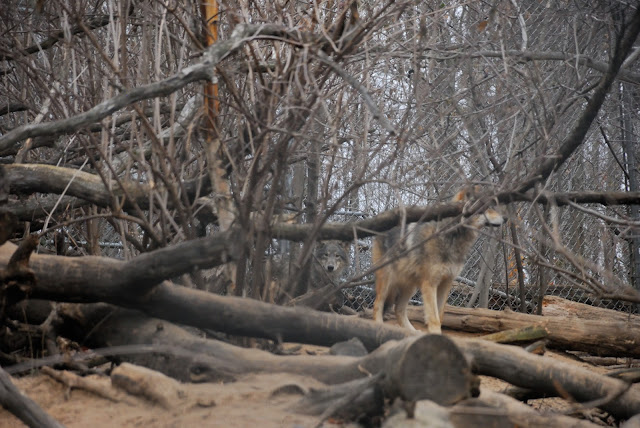I had never heard a mountain lion make noise, but one of them was actually quite vocal, as you can hear here. Although there's bit of interference from the wind, you should be able to hear the distinctive noise once, then twice in short succession, before the two individuals in the enclosure provoke each other and there's a bit of an eruption.
Wednesday, November 22, 2017
And Cats! (Oh my!)
Wildlife Science Center also has various cats, bears, porcupines, arctic foxes, coyotes, owls, hawks, and more. It probably won't surprise any of you that I loved watching the cats. They have bobcats (Lynx rufus), mountain lions (Puma concolor), and lynx (Lynx canadensis), but I only managed to get pictures of the last two. The bobcats were snuggled up in their hammock mostly out of sight.
I had never heard a mountain lion make noise, but one of them was actually quite vocal, as you can hear here. Although there's bit of interference from the wind, you should be able to hear the distinctive noise once, then twice in short succession, before the two individuals in the enclosure provoke each other and there's a bit of an eruption.
I had never heard a mountain lion make noise, but one of them was actually quite vocal, as you can hear here. Although there's bit of interference from the wind, you should be able to hear the distinctive noise once, then twice in short succession, before the two individuals in the enclosure provoke each other and there's a bit of an eruption.
Sunday, November 19, 2017
Foxes!
The Wildlife Science Center is primarily dedicated to wolves, but they have a variety of other animals too. I was particularly excited to see their foxes (Vulpes vulpes), because they have three domesticated foxes from the Siberian Farm Fox Experiment. The foxes in this experiment are a significant part of why I became interested in domestication and have been a considerable motivator in my research.
In the 1950s, Russian geneticist Dmitry Belyayev started selectively breeding foxes that were being farmed for their fur by choosing the individuals of each generation that exhibited the least aggressive behavior when their cages were approached by a human. In addition to producing tamer foxes, within just a few generations these foxes had more white in their coats, vocalized frequently, and sought physical contact with humans. What was most surprising about these changes was how rapidly they occurred. For example, traits such as tail wagging and seeking human contact emerged within 4-6 generations and were exhibited by 50% of pups in about 30 generations.
Evolutionary anthropologist Brian Hare has also demonstrated that these domesticated foxes are better able to use social cues such as pointing and gazing to find hidden food than the other farm foxes are. These findings parallel Hare's previous work showing that dogs are better at using these cues than either wolves or great apes, leading to the "self-domestication hypothesis" that perhaps a crucial piece of human evolution involved selection against aggression that might have led to increased capacities for cooperation and communication. This hypothesis is essentially why I am now in an anthropology department rather than a biology or psychology department.
I have read many papers and attended several talks on these foxes, but I had never seen one in person. Here are the three domesticated foxes from Wildlife Science Center, as well as their one red fox for comparison.
In the 1950s, Russian geneticist Dmitry Belyayev started selectively breeding foxes that were being farmed for their fur by choosing the individuals of each generation that exhibited the least aggressive behavior when their cages were approached by a human. In addition to producing tamer foxes, within just a few generations these foxes had more white in their coats, vocalized frequently, and sought physical contact with humans. What was most surprising about these changes was how rapidly they occurred. For example, traits such as tail wagging and seeking human contact emerged within 4-6 generations and were exhibited by 50% of pups in about 30 generations.
Evolutionary anthropologist Brian Hare has also demonstrated that these domesticated foxes are better able to use social cues such as pointing and gazing to find hidden food than the other farm foxes are. These findings parallel Hare's previous work showing that dogs are better at using these cues than either wolves or great apes, leading to the "self-domestication hypothesis" that perhaps a crucial piece of human evolution involved selection against aggression that might have led to increased capacities for cooperation and communication. This hypothesis is essentially why I am now in an anthropology department rather than a biology or psychology department.
I have read many papers and attended several talks on these foxes, but I had never seen one in person. Here are the three domesticated foxes from Wildlife Science Center, as well as their one red fox for comparison.
 |
| Caught mid-yawn! |
Saturday, November 18, 2017
Wolves!
I spent most of this past week at the Wildlife Science Center in Minnesota. With wolves. We were collecting samples for an ongoing research project, but in between I was able to take some photos.
They are beautiful animals, aren't they? It was a fascinating trip, and I learned a lot. But more on that later.
They are beautiful animals, aren't they? It was a fascinating trip, and I learned a lot. But more on that later.
Subscribe to:
Posts (Atom)


























